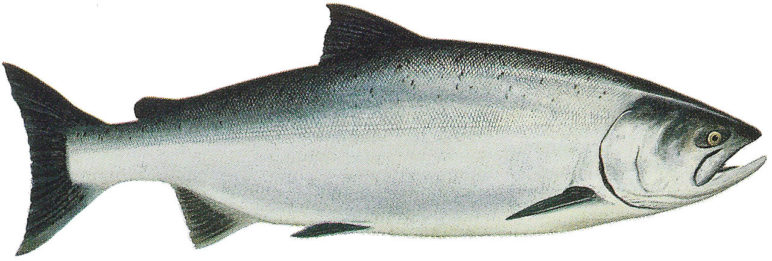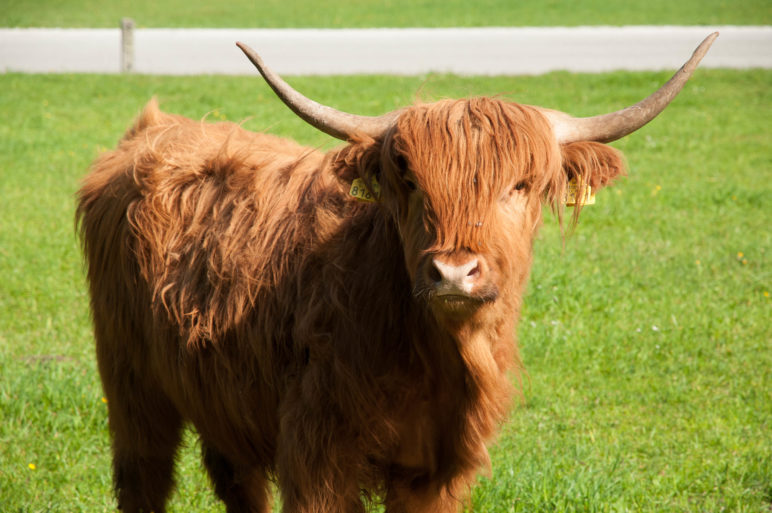Nick Pate can look across the street from his farm into Washington’s Snohomish River, where five salmon species swim to their spawning beds. The salmon are fighting a losing battle with habitat loss, declining water quality, and rising water temperatures. Chinook are among the hardest hit—less than 10 percent of their historic numbers now swim in the river.
When Nick bought his farm a little over a decade ago, he found a small creek running through it, flowing straight to the Snohomish. Its banks had been nearly stripped of vegetation. Riparian habitats—the diverse and delicate ecosystems along waterways—protect water quality and have an enormous impact on aquatic life, yet they are vanishing from Washington’s landscape. Since its statehood in 1889, Washington has lost over 50 percent of its riparian habitat. That loss is a key obstacle to salmon recovery.
Over a third of Washington’s salmon streams on private land pass through agricultural zones but state programs to aid farmers like Nick in protecting streamside habitat aren’t working. The programs rely on voluntary enrollment, offering farmers financial incentives to participate. In exchange, almost all programs require farmers to take the riparian acres entirely out of production. For most producers, the benefits of enrolling aren’t enough to offset the financial loss. The mismatched tradeoff has created a stakeholder standoff, pitting farmer livelihoods against salmon survival, and crippling progress on riparian restoration on farmland.

Three years ago, Nick began experimenting with agroforestry—a farming technique in which producers include trees and shrubs throughout crops and pastures to boost both resilience and yields. Agroforestry is not new. Generations of indigenous people all over the world have practiced agroforestry, and it remained common on Cascadian farms and elsewhere through the early 20th century. Today, however, most commercial farmers in Cascadia ignore it. Nick believes agroforestry could hold the key to protecting the creek water and keeping his farm competitive.
Washington’s riparian crisis
Thriving riparian buffers cool stream temperatures by as much as 10 degrees Fahrenheit, cut erosion, and filter fertilizer runoff and pesticide drift before those toxins enter the water. Those services make them critical for salmon survival, yet these ecosystems continue to degrade and disappear in Washington.
In 2007, Nick enrolled some of his creekside acres in the Conservation Reserve Enhancement Program (CREP), a federally funded program for conserving environmentally sensitive areas on agricultural land. In Washington, CREP funding supports riparian buffer restoration on farmland. The program covered the cost of planting native trees and shrubs along the creek and pays Nick an annual rent for the land that he’s taken out of production. The payments amount to less than $400 per acre each year. In exchange, Nick agreed not to graze his animals or harvest anything in the buffer, nor grow anything other than CREP-approved native plants. Nick says the money doesn’t cover the cost of his lost production.
Thriving riparian buffers cool stream temperatures by as much as 10 degrees Fahrenheit, cut erosion, and filter fertilizer runoff and pesticide drift before those toxins enter the water.

Nick isn’t alone in his disappointment with CREP. Farmers across Washington have enrolled fewer than 6 percent of the state’s total qualifying stream miles in the program. Carrie Brausieck, a resource planner at the Snohomish Conservation District, believes the program’s rigid “no touch” rules—which prohibit farmers from using the enrolled acres in any way—discourage enrollment because payments are too low to make participation pencil. The financial loss from taking riparian acres out of production may be hardest on smaller farms, like Nick’s, where the program’s minimum buffer widths—which range from 35 to 100 feet—can eat a large portion of total farmable land, including many of the most productive acres.
Agroforestry’s benefits for farmers and riparian health
As Nick’s frustrations grew, the Snohomish Conservation District approached him three years ago with an alternative to the no-touch model. Instead of paying Nick to keep his land out of production, the district wanted to help him create a working riparian buffer, using agroforestry practices to produce revenue while still protecting the water and fish habitat.
Stay informed! Sightline has a new, twice-monthly Farms & Forests newsletter!
The district gave Nick a small grant, coupled with technical design assistance, to plan and plant three agroforestry trials near the creek. In one area he planted a food forest, intermingling aronia berries, currants, and huckleberries with hazelnuts, walnuts, and chestnuts. He planted rows of cider apples in his hayfield to create an alley cropping system. The land produces two distinct yet symbiotic crops—the hay keeps orchard weeds down, and the trees shade the grass to extend the growing season. In a third area, he installed a silvopasture—a combination of trees and pasture—for his Scottish Highland cattle, adding alder, willow, walnut, and locust trees to a grazing field. The trees reduce heat stress for the cattle, the locust provides a second forage source, and the walnuts will produce nuts to sell commercially as well as income from timber.

None of the trials come right up to the creekside. Rather, Nick situated them like a second line of defense, behind thinner strips of native plants that directly border the waterway. The combined width of the native plant alleys plus the agroforestry swaths is larger than CREP’s buffer requirements, creating more opportunity to filter fertilizer and pesticide runoff before it reaches the creek.
The intermingling of plant species above ground supports a more diverse microbial world below. That complex web underpins soil health, nutrient availability, and pollinator abundance. Together these benefits can reduce reliance on synthetic fertilizers and pesticides, saving farmers money and reducing toxic loads in nearby waterways. When designed well, working buffers can still achieve the water quality and cooling benefits of no-touch native riparian buffers.
Along with lower input costs, well-designed agroforestry systems can increase overall yield compared with monocultures on the same acreage. And much of the increased yield comes from high-value crops, like nuts and berries.
Nick’s three agroforestry trials could add nearly a dozen new income sources to his farm—from currants to timber to hazelnuts. That’s been one of the most important benefits of agroforestry for him, as it’s made his farm more resilient to market and weather volatility.
Meeting the challenges of scaling up
Farmers face enough risks from the weather and markets; adopting new farming practices adds the risk of the unknown. Well-trained agroforestry technicians, along with startup financial support, can help smooth the transition from conventional cropping to agroforestry.
A smart agroforestry plan can ease startup by including fast-growing species that provide more immediate returns.

Orchard trees can take up to a decade to reach peak production, and farmers on tight budgets may not have the reserves to wait out those lean years. A smart agroforestry plan can ease startup by including fast-growing species that provide more immediate returns. Conservation programs could also provide bridge funds to help farmers make up lost income during the initial years.
Polycrop systems also complicate harvesting as many crops require specialized processing before they are ready for market. When those facilities aren’t nearby, the added supply chain complexity can cut into profits. Agroforestry technicians can design systems that take into account existing markets and infrastructure, though these factors may limit crop options. In Nick’s case, he’s hoping to process the cider from his apples onsite, adding value to the product.
And finally, there’s the wildlife. Beavers have now moved into Nick’s creek, drawn by the newly inviting surroundings. Though beavers are important for restoring salmon habitat, they can also destroy nearby crops, making them not only a nuisance but also a liability. Similarly, as it’s become harder to mow the hay with the new cider apple trees in the way, enterprising voles have moved in to feast on the trees. When Nick does mow, deer are all too happy to munch on the young trees. These challenges are often greatest during the startup years, making bridge funds and technical support particularly important.
Realizing the promise of agroforestry depends on investment
Though agroforestry is garnering national attention for its climate, ecological, and economic benefits, support for implementation in Cascadia remains meager. Nick’s grant was a one-off, not a sustained program. Washington’s Department of Ecology does not consider agroforestry a priority funding opportunity and its latest water quality grant report doesn’t mention the practice. And the recently announced $45 million in Puget Sound Acquisition and Restoration (PSAR) Fund grants to restore Washington salmon habitat didn’t include funding for agroforestry anywhere in the state.
The lack of investment means most farmers in the region don’t know about agroforestry, and most conservation districts don’t have technicians like Carrie with the expertise to design high-functioning systems. Nick is willing to wrestle with the startup challenges of agroforestry in the hope of long-term benefits for the salmon and his farm, but he’s a rarity. State and federal conservation funding programs will need to prioritize agroforestry as a viable tool for riparian restoration before more Cascadian producers consider it.
The lack of investment means most farmers in the region don’t know about agroforestry, and most conservation districts don’t have technicians like Carrie with the expertise to design high-functioning systems.

All this comes in the midst of a larger conversation about the failings of riparian habitat restoration in Washington. Many Northwest tribes are concerned that existing voluntary incentive programs aren’t enough to save the salmon. Though agroforestry could help make voluntary programs more attractive to farmers, it won’t address the broader question of whether the state should more strictly regulate streamside restoration. Still, these techniques may offer a place to start bridging the stakeholder divide, offering a pathway to meet priorities of the agricultural community, regulatory agencies, and many western Washington tribes.
More extreme droughts and floods loom on the horizon for Cascadia’s farmers. As these weather events become more common, resilient and multi-modal farming methods like agroforestry may become necessary for continued stable food production in the region. Adding trees to standard farming operations could also have climate benefits, a topic Sightline will explore in a future article. As Carrie Brausieck emphasizes, farming must adapt to a changing climate before the crops fail and the salmon disappear.
Thank you to Nick Pate and Carrie Brausieck for sharing their stories and informing this article.
Margaret Morales is the lead researcher for Sightline’s Farms and Forests program. She received her Master’s from The University of British Columbia’s Institute for Resources, Environment, and Sustainability where she was a Bridge Fellow focusing on issues of public health and the environment. If you’d like to contact Margaret or request an interview, please contact Communications Manager Anne Christnovich.
Appendix: Five agroforestry techniques
Agroforestry is a highly site-specific farming technique. Application can vary from field to field and farm to farm based on production goals, microclimate, and access to technical support, equipment, and markets. Despite its infinite permutations, technicians divide agroforestry techniques into five broad categories.
Alley cropping has a long history in Washington’s commercial orchards. The practice involves planting low-growing crops like peas or grasses between rows of trees or shrubs. Besides keeping weeds down, the faster-growing alley crops provide income while farmers wait for the trees fill in and reach commercial production levels, which can take 7 to 10 years.
Food forests incorporate multiple crops—fruit, nuts, roots, mushrooms, and even timber—in diverse stands. The diversity can withstand more weather variation and provide farmers with the insurance of several income sources.
Silvopasture incorporates trees into grazing areas. The trees create additional forage for ruminants, reduce heat stress, and extend the grazing season.
Windbreaks use trees as protective screens surrounding crops to reduce erosion and crop damage.
Riparian buffers are streamside plantings of trees, shrubs, and grasses. Often these include food-producing species like tree nuts and berries.


Comments are closed.